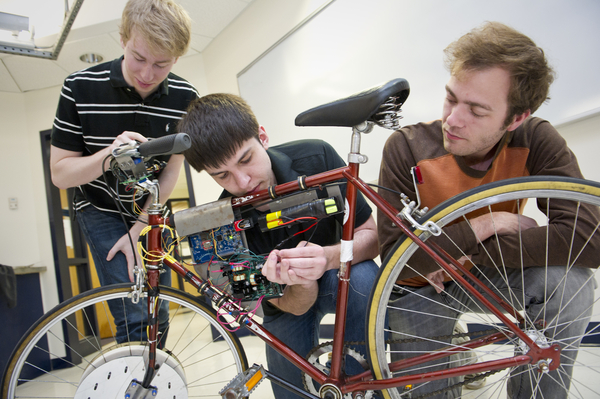Wheeling toward a sustainable future

When compared with a four-mile car ride, a four-mile bicycle ride keeps about 15 pounds of pollutants out of the air we breathe, according to the Worldwatch Institute. But a host of challenges tend to stand in our way, not the least of which may be the piercing pain we feel in our quadriceps while pedaling up steep hills.
That’s why a team of Northeastern engineering students has created a technology called HyCycle, which maintains the efficiency of a bike ride while providing a boost for those inimitable inclines.
The student-researchers — Brian Carbone, Brad Courville, Brian Martins, Jason Rudbart, Scott Rand and Eddie Vaisman — designed the device for a senior capstone project. Electrical and computer engineering associate professor Waleed Meleis served as the project’s faculty adviser. He said the device is based on technology developed by electrical and computer engineering associate professor Nian-Xiang Sun.
The goal of the project, said Martins, E’12, was to “replace motorized bikes and also to attract more people to the bicycle as a means of transportation with urban environments.”
Each rotation of a traditional bicycle’s front wheel generates mechanical energy, which is either used to push the bike if it’s on either a flat or inclining surface or, in the case of a descent, lost to the environment as kinetic energy.
HyCycle, on the other hand, stores that energy for later use. The front wheel is outfitted with a circular array of magnets and coils. When the wheel rotates, the magnets pass over the coils and generate a current, which is transferred through wires to a lithium ion battery.
When the rider needs a little extra help to get him through a tough portion of a long ride, he merely switches a knob on his handlebar, which allows current from the battery to flow back to the coils and push them across the magnets. Voila! The wheel rotates without requiring input from the rider.
Data about velocity, battery charge level, harvested energy and energy used are collected via a microcontroller and transmitted to an Android phone application designed by the student-researchers. The app allows riders to visualize riding statistics.
Rand, E’12, who worked on the electric motor design and both the energy harvesting and driving techniques, said the technology is a self-sustainable system that never requires outside resources other than human pedal power.
The team has filed a patent application through Northeastern’s Center for Research Innovation. “I would like to see a future iteration of the HyCycle become a marketable product,” said Courville, E’12. “I think that the technology has a great deal of potential, and with a few design optimizations and a professional manufacturing process it could benefit a lot of people.”





